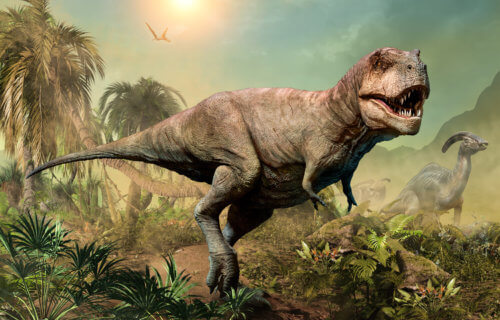BIRMINGHAM, United Kingdom — What’s keeping humans from living to be 150 or even 200 years-old? Instead of pointing the finger at fast food and smoking, a fascinating new theory suggests that you may have the dinosaurs to blame for humanity’s current rate of aging.
Did a velociraptor drink up the entire fountain of youth and not leave any for the rest of us? Not quite, but the longevity bottleneck hypothesis does assume that human aging may be influenced by millions of years of dinosaur domination. This is not just limited to humans, either. This theory could explain why various long-lived mammals age more rapidly than many reptiles. Certain reptiles and amphibians show no significant signs of biological aging, but all mammals (including humans) show clear signs of aging as the years pass by.
Connecting the presence of the dinosaurs on Earth over 100 million years ago with the aging processes of today’s mammals, the hypothesis suggests that during the Mesozoic Era (66-250 million years ago), mammals living on our planet faced constant pressure for rapid reproduction during the “reign of dinosaurs” – a period lasting over 100 million years. This persistent evolutionary pressure, according to the theory, led to the loss or inactivation of genes associated with long life in early mammals.

“The ‘longevity bottleneck hypothesis’ may shed light on evolutionary forces that have shaped the way that mammals have aged over millions of years. While we see humans among different species that are among the longest living animals, there are many reptiles and other animals that have a much slower aging process and show minimal signs of senescence over their lives,” says João Pedro de Magalhães, Professor of Molecular Biogerontology in the Institute of Inflammation and Aging at the University of Birmingham, in a media release.
“Some of the earliest mammals were forced to live towards the bottom of the food chain, and have likely spent 100 million years during the age of the dinosaurs evolving to survive through rapid reproduction. That long period of evolutionary pressure has, I propose, an impact on the way that we humans age.”
“We see examples in the animal world of truly remarkable repair and regeneration. That genetic information would have been unnecessary for early mammals that were lucky to not end up as T Rex food. While we now have a plethora of mammals including humans, whales and elephants that grow big and live long, we and these mammals live with the genetic hangups from the Mesozoic era and we age surprisingly faster than many reptiles,” the professor continues.
“While just an hypothesis at the moment, there are lots of intriguing angles to take this, including the prospect that cancer is more frequent in mammals than other species due to the rapid aging process.”
The study is published in the journal BioEssays.
You might also be interested in:
- Dinosaur Feathers From 125 Million Years Ago Reveal The Evolution Of Modern Birds
- Biggest meat-eating dinosaur that ever lived hunted underwater!
- Best Anti-Aging Serums: Top 7 Brands Most Recommended By Beauty Experts
- You can live to 150? Scientists create app that shows human lifespan could nearly double


I wonder whether this also explains why mammals are viviparous, as producing young that can, at least in principle, follow the adults immediately and be protected by them would seem to make sense if dinosaurs are around. It might also explain why mammals have fewer young, because of the cost involved in sustaining growing offspring in one’s body compared to producing eggs.